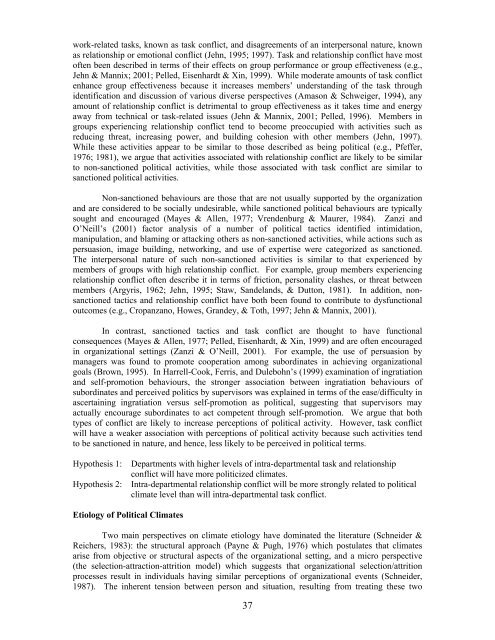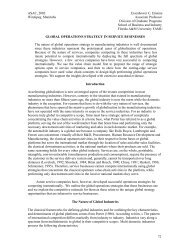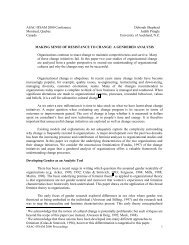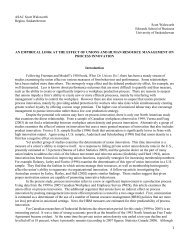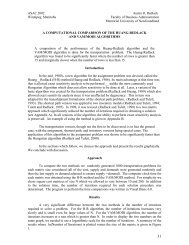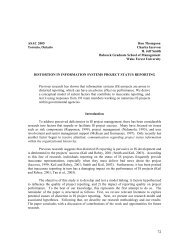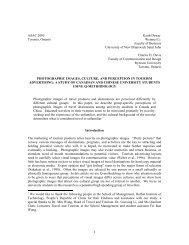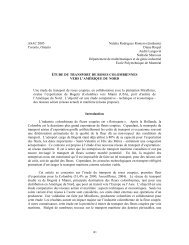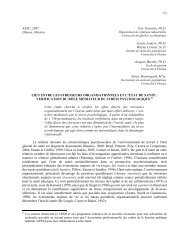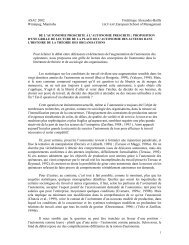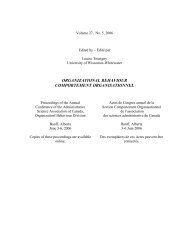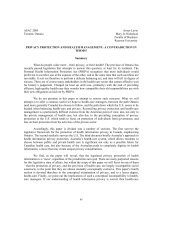ASAC 2003Halifax, Nova ScotiaWendy A. Darr (student)Gary JohnsJMSB, Concordia UniversityPOLITICAL CLIMATES: THEORETICAL PROCESSES AND MULTI-LEVELANTECEDENTSAimed at understanding the development of political climate in university departments,this study explored the theoretical role of two types of conflict and multi-levelantecedents (paradigm development, rank heterogeneity, and role perceptions). Findingsprovide insight into this phenomenon, addressing some of the gaps in research on thisarea.<strong>Organizational</strong> Politics<strong>Organizational</strong> politics (OP) involves behaviour that is directed toward furthering self orgroup interest at the expense of others’ well being (Kacmar & Baron, 1999). Research on OP hastypically sought to understand the antecedents and consequences of politics using single-levelmodels, usually directed at the individual level of analysis (Kacmar & Baron, 1999). Whileresearchers agree that OP can exist at different levels of analysis (Drory & Romm, 1990), theyhave failed to adequately examine OP as a group-level construct. In addition, it is beingincreasingly recognized that organizational phenomena do not occur in a single-level vacuum andare often a product of dynamic multi-level processes (Chan, 1998). While the need for crosslevelmodels in OP research is reflective of the field of organizational behaviour (OB) in general(Cappelli & Sherer, 1991; Johns, 2001; Mowday & Sutton, 1993; Rousseau & Fried, 2001),another concern specific to OP research is the lack of empirical evidence concerning thetheoretical underpinnings of this phenomenon (Welsh & Slusher, 1986). The purpose of thisstudy is to address some of these identified gaps in research on organizational politics. This isaccomplished by examining politics at the sub-organizational level by identifying theoreticalprecursors to politics by exploring the effects of multi-level antecedents (individual,departmental, disciplinary) on departmental political climates.Theoretical assumption: Role and nature of ConflictImplicit in Pfeffer’s (1981) definition of OP is the required condition of dissensus orconflict, which gives rise to political activities within groups or organizations. The precursoryrole of internal or organizational conflict is also emphasized in Cyert and March’s (1963) andNarayan and Fahey’s (1982) perspectives on organizations. Yet empirical research has failed toadequately examine the impact of group conflict processes on political activity or perceptions. AsWelsh and Slusher (1986) explained, previous studies (e.g., Pfeffer & Moore, 1980) have simplyinferred the presence of dissensus in decision making, never really measuring or verifying itspresence. Although Welsh and Slusher (1986) demonstrated a positive association betweenconflict and the use of influence strategies in colleges with interdependent departments, severallimitations (e.g., restricted focus on a single decision, college as the unit of analysis) restrict thegeneralization of their findings to routine decision making in organizational groups. Therefore,there still remains a need to understand the role of conflict processes in politics. Consequently,the multi-dimensional nature of conflict (Jehn, 1995; 1997) has yet to be explored in terms ofpotential differential effects of various types of conflict on politics.Conflict has mainly been distinguished in terms of disagreements over substantive or36
work-related tasks, known as task conflict, and disagreements of an interpersonal nature, knownas relationship or emotional conflict (Jehn, 1995; 1997). Task and relationship conflict have mostoften been described in terms of their effects on group performance or group effectiveness (e.g.,Jehn & Mannix; 2001; Pelled, Eisenhardt & Xin, 1999). While moderate amounts of task conflictenhance group effectiveness because it increases members’ understanding of the task throughidentification and discussion of various diverse perspectives (Amason & Schweiger, 1994), anyamount of relationship conflict is detrimental to group effectiveness as it takes time and energyaway from technical or task-related issues (Jehn & Mannix, 2001; Pelled, 1996). Members ingroups experiencing relationship conflict tend to become preoccupied with activities such asreducing threat, increasing power, and building cohesion with other members (Jehn, 1997).While these activities appear to be similar to those described as being political (e.g., Pfeffer,1976; 1981), we argue that activities associated with relationship conflict are likely to be similarto non-sanctioned political activities, while those associated with task conflict are similar tosanctioned political activities.Non-sanctioned behaviours are those that are not usually supported by the organizationand are considered to be socially undesirable, while sanctioned political behaviours are typicallysought and encouraged (Mayes & Allen, 1977; Vrendenburg & Maurer, 1984). Zanzi andO’Neill’s (2001) factor analysis of a number of political tactics identified intimidation,manipulation, and blaming or attacking others as non-sanctioned activities, while actions such aspersuasion, image building, networking, and use of expertise were categorized as sanctioned.The interpersonal nature of such non-sanctioned activities is similar to that experienced bymembers of groups with high relationship conflict. For example, group members experiencingrelationship conflict often describe it in terms of friction, personality clashes, or threat betweenmembers (Argyris, 1962; Jehn, 1995; Staw, Sandelands, & Dutton, 1981). In addition, nonsanctionedtactics and relationship conflict have both been found to contribute to dysfunctionaloutcomes (e.g., Cropanzano, Howes, Grandey, & Toth, 1997; Jehn & Mannix, 2001).In contrast, sanctioned tactics and task conflict are thought to have functionalconsequences (Mayes & Allen, 1977; Pelled, Eisenhardt, & Xin, 1999) and are often encouragedin organizational settings (Zanzi & O’Neill, 2001). For example, the use of persuasion bymanagers was found to promote cooperation among subordinates in achieving organizationalgoals (Brown, 1995). In Harrell-Cook, Ferris, and Dulebohn’s (1999) examination of ingratiationand self-promotion behaviours, the stronger association between ingratiation behaviours ofsubordinates and perceived politics by supervisors was explained in terms of the ease/difficulty inascertaining ingratiation versus self-promotion as political, suggesting that supervisors mayactually encourage subordinates to act competent through self-promotion. We argue that bothtypes of conflict are likely to increase perceptions of political activity. However, task conflictwill have a weaker association with perceptions of political activity because such activities tendto be sanctioned in nature, and hence, less likely to be perceived in political terms.Hypothesis 1:Hypothesis 2:Departments with higher levels of intra-departmental task and relationshipconflict will have more politicized climates.Intra-departmental relationship conflict will be more strongly related to politicalclimate level than will intra-departmental task conflict.Etiology of Political ClimatesTwo main perspectives on climate etiology have dominated the literature (Schneider &Reichers, 1983): the structural approach (Payne & Pugh, 1976) which postulates that climatesarise from objective or structural aspects of the organizational setting, and a micro perspective(the selection-attraction-attrition model) which suggests that organizational selection/attritionprocesses result in individuals having similar perceptions of organizational events (Schneider,1987). The inherent tension between person and situation, resulting from treating these two37
- Page 1 and 2: Volume 24, No. 5, 2003Edited by/Éd
- Page 4 and 5: Pursey HeugensGreg IrvingRoderick I
- Page 6 and 7: TABLE OF CONTENTS - TABLE DES MATI
- Page 8 and 9: study of power displays in mixed-ge
- Page 10 and 11: on expectations and behaviour (Berg
- Page 12 and 13: TaskThis study required the use of
- Page 14 and 15: Task-Gender (male-stereotyped or fe
- Page 16 and 17: It is important to understand the s
- Page 18 and 19: Crown, C.L. & Cummins, D.A. (1998).
- Page 20 and 21: Smith-Lovin, L., & Brody, C. (1989)
- Page 22 and 23: Table 2Summary of Descriptive Stati
- Page 24 and 25: Table 4Summary of Interaction of Ge
- Page 26 and 27: ASAC 2003Halifax, Nova ScotiaIain L
- Page 28 and 29: the interrelationships among the MB
- Page 30 and 31: studies (Friedman and Sarros, 1989;
- Page 32 and 33: This study demonstrated that emotio
- Page 34 and 35: Anxiety, Stress and Coping, in pres
- Page 36 and 37: Washington, DC: Taylor and Francis,
- Page 38 and 39: Table 2Overall Goodness-of-Fit Indi
- Page 40 and 41: ζ 3Depersonalizationη 3β 3,1 (+)
- Page 44 and 45: views independently, gave rise to S
- Page 46 and 47: track assistant, associate, and ful
- Page 48 and 49: ole conflict are positively related
- Page 50 and 51: Table 3. Regression of climate and
- Page 52 and 53: interests.We speculate the null eff
- Page 54 and 55: DOOP and short for DOOP scales,”
- Page 56 and 57: Pelled, L. H., “Demographic diver
- Page 58 and 59: esulting increase in discretion ove
- Page 60 and 61: al., 1995). However, the distinctio
- Page 62 and 63: ise to strong pressures for conform
- Page 64 and 65: presented with a complete list of a
- Page 66 and 67: Table 3QAP Regression Coefficients
- Page 68 and 69: ConclusionResearchers of social inf
- Page 70 and 71: suggestions for further research.
- Page 72 and 73: performing on the job.” Presumabl
- Page 74 and 75: positively related to performance i
- Page 76 and 77: proposed hypotheses were supported.
- Page 78 and 79: ConclusionThis research has made se
- Page 80 and 81: Be more enthusiastic and exert extr
- Page 82 and 83: Table 2Correlations Among the Laten
- Page 84 and 85: performance expectations on feedbac
- Page 86 and 87: changements qui s’opèrent dans l
- Page 88 and 89: structures, politiques, systèmes,
- Page 90 and 91: comportements liés à la communica
- Page 92 and 93:
Tableau 2Échelles de mesure de la
- Page 94 and 95:
prédiction des compétences clés
- Page 96 and 97:
organisation n’est pas uniforme e
- Page 98 and 99:
complètement ce construit. Ces cha
- Page 100 and 101:
Wagner, R.K. and Sternberg, R.J. (1
- Page 102 and 103:
What is a toxin handler?In two arti
- Page 104 and 105:
potentially limited scope and conte
- Page 106 and 107:
work role demands. In this survey,
- Page 108 and 109:
The three factors in this rotated f
- Page 110 and 111:
and service orientation, the abilit
- Page 112 and 113:
ASAC 2003Halifax, Nova ScotiaLisa M
- Page 114 and 115:
self-appraisal group reacted more n
- Page 116 and 117:
effect of voice are the value-expre
- Page 118 and 119:
“Strongly Disagree” to “Stron
- Page 120 and 121:
esults suggest that incorporating s
- Page 122 and 123:
Personality and Social Psychology,
- Page 124 and 125:
Table 1Means, Standard Deviations,
- Page 126 and 127:
Table 3Test of the Mediating Role o
- Page 128 and 129:
ASAC 2003Halifax, Nova ScotiaAnn Fr
- Page 130 and 131:
individual level, polychronicity is
- Page 132 and 133:
construct.Drawing on computer-media
- Page 134 and 135:
Consequence: Impact on Work Overloa
- Page 136 and 137:
Conversation complexity may also mo
- Page 138:
Implications for practiceFuture res
- Page 141 and 142:
ReferencesAncona, D.G., Goodman, P.
- Page 143 and 144:
no. 3 (1994): 381-391.Macan, T.H.,
- Page 145 and 146:
ASAC 2003Halifax, Nova ScotiaIan R.
- Page 147 and 148:
Assessing Measures: Affective Commi
- Page 149 and 150:
implications of psychological contr
- Page 151 and 152:
commitment, affective commitment, c
- Page 153 and 154:
Motivational Process Variables. Amo
- Page 155 and 156:
DiscussionThe main purpose of this
- Page 157 and 158:
approaches zero. In the present stu
- Page 159 and 160:
Extension and test of a three-compo
- Page 162 and 163:
Table 1Descriptive Statistics and Z
- Page 164 and 165:
Table 3Standardized Factor Loadings
- Page 166 and 167:
Table 5Hierarchical Regression Anal
- Page 168 and 169:
ASAC 2003Halifax, Nova ScotiaJoan F
- Page 170 and 171:
ASAC 2003Halifax, Nova ScotiaArla D
- Page 172 and 173:
ASAC 2003Halifax, Nova ScotiaIvy Ky
- Page 174:
ASAC 2003Halifax, Nova ScotiaNina D


